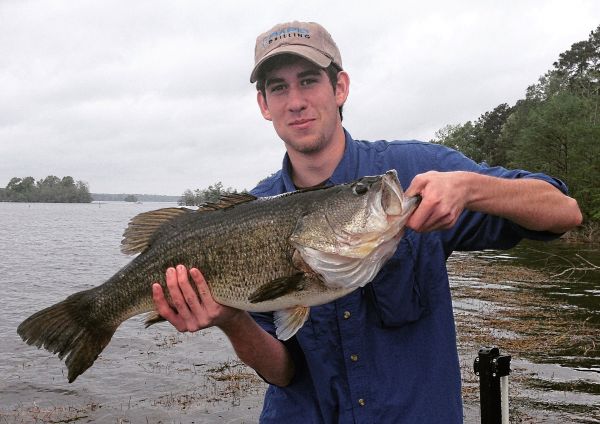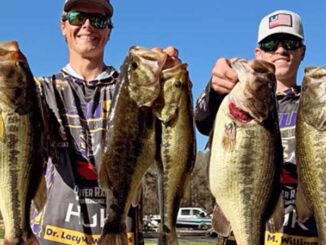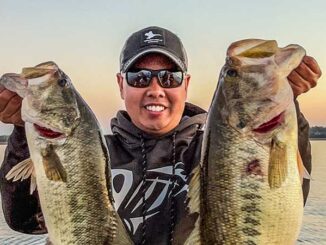
Always use two hands — one on the lip and one under the belly — to hold big fish, biologist says
Catching a true trophy largemouth is the lifelong goal of countless bass anglers, and if you’re ever lucky enough to get your hands on a certified 10-pounder — especially if you want to catch and release the fish — proper handling techniques will definitely increase its chances for long-term survival.
Sean Kinney, the biologist manager at Toledo Bend for the Louisiana Department of Wildlife and Fisheries, said it’s important to handle the fish as little as possible, and also to get it in your livewell as quickly as you can.
“When you do catch those big fish, you should hold them by the jaw with one hand and then support the majority of its weight by cradling the fish underneath the belly with your other hand,” Kinney said. “If possible, the best way is to kind of carry them like a football right next to your body so they don’t flip out of your hands.”
The lower jaw of a big bass is particularly susceptible to being broken if it is used as a fulcrum when prying a hook free, and also if the fish is held up for display with only one hand, Kinney said.
“The more they weigh, the better chance you have of injuring them by holding them by the jaw with one hand. The Texas Share Lunker Program necropsied a few that died and a good percentage of their jaws were broken, and they assumed that was mainly from handling them by the lower jaw,” he said.
Getting the fish in a livewell
After it’s landed, getting the fish into an aerated livewell as soon as possible should be the angler’s next goal, he said.
“Getting them off the hook and not breaking its jaw is just the first step,” Kinney said. “Getting him in the livewell and not holding him up to take pictures for five minutes is the second.
“Taking pictures is ok, but you can dunk him in the livewell and leave him there until you get everything settled, and then pick him up and take the pictures.”
It’s important to keep track of how long the bass actually stays out of water, especially when displaying the fish for cameras, he said.
“In general, what I’ve been told was, if you can’t hold your breath for that long, then you should probably put him back in the water,” he said.
Rubber-coated landing nets with roughly 1-inch holes also aid in keeping a fish healthy, Kinney said.
“The ones that are just nylon mesh or other harsh material tend to rub a lot of the slime off, and the net can get in the gills,” he said. “And don’t keep touching him repeatedly, which also rubs a lot of slime off.”
Time of year
The time of year you catch a lunker can also play a role in its long-term survival, Kinney said.
Landing a big fish in winter or early spring and keeping it healthy is much easier than a lunker caught in the dead of summer, he said.
“If you’re fishing a tournament in February or March, you can catch that fish in the morning if you have a good livewell, and keep it until weigh-in time because of the air and water temperature,” he said. “But in the summer months, oxygen levels in the water go down due to the temperatures, and you can’t hold that fish very long. They’re going to get stressed out in that water coming into that livewell, which is coming off the surface and is a lot warmer than it is in the springtime.
“The higher the water temperature is in the lake, anything above 70 or 75 degrees, if you catch one of those fish and want to enter it into a program, you should probably put it in the livewell, start your engine, double check you’ve got the aerator running and you’re not on recirculate so it dries out, and then immediately head toward a weigh-in station.”
Survival
Kinney said several of the 10-pound plus trophy bass at Toledo Bend, which are tagged and released through the Toledo Bend Lunker Program, are being caught again by other anglers over the years.
“That’s happening, so we know some are surviving,” Kinney said. “As for how many, we don’t really have a good handle on that. And we know some are not surviving, because we find some from time to time that are floating back up after they’ve been released.”
Overall though, if you want the best odds of keeping a big bass alive so that it can be released, touch it as little as possible and get it in an aerated livewell as soon as you can, he said.
“Get it in the boat quick, try not to over-handle him and get him in the livewell. Take him back out to get some pictures and then put him back in there and leave him alone. The more you open it up to show everyone, the worse you’re going to be” Kinney said. “Then depending on the temperature outside and the water temperature, get him to a weigh-in station as soon as you can.”


